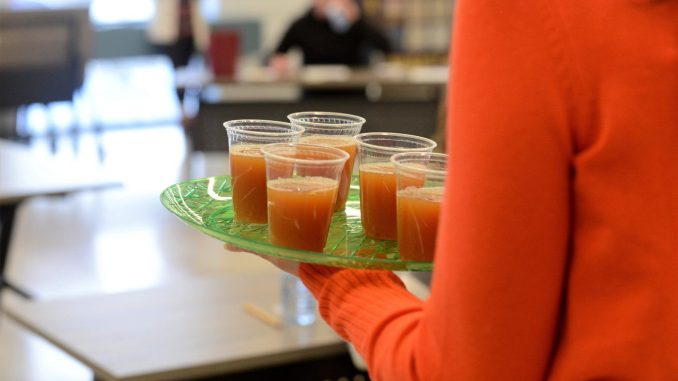
By J.P. Antonacci, Local Journalism Initiative Reporter, The Hamilton Spectator
By the fifth glass of apple cider, I could appreciate the judges’ plight.
Which of the offerings before me had the best balance of sweetness and tart? Did the flavours excite my tastebuds or fall flat? And what was up with that weird aftertaste?
Fortunately, my decidedly uninformed opinion was not counted on to crown the best sweet non-alcoholic cider in Ontario. That task fell to a panel of five industry experts who gathered at the agricultural research station in Simcoe on Tuesday for a competition organized by the Ontario Fruit and Vegetable Convention (OFVC).
You would be hard-pressed to find a more conscientious bunch. The judges carefully evaluated the five entrants, their brows furrowed as they gauged the cider’s appearance and colour, noting how much sediment was in each plastic cup and how the liquid ran down the sides.
“You need to take it seriously because people have put a genuine effort into doing this,” said Lisa Herrewynen, operations manager at the Norfolk Fruit Growers’ Association, back for her second year as a contest judge.
“I’m so excited to do this. I’ve wanted to do this for years,” added first-time judge Evan Elford, a new crop development specialist with the province.
Taking tiny sips and swishing thoughtfully before turning back to their scoresheets — which omitted the cider makers’ names to avoid favouritism — the judges dumped excess liquid into a bucket and nibbled crackers between rounds to cleanse their palettes.
The first two ciders that were shaken and poured out looked and tasted as I thought cider should. But the arrival of a pale, clear entry caused a stir.
“Are we sure this is the sweet cider and not the hard cider?” quipped judge Josh Mosiondz from the provincial agriculture ministry, referring to the OFVC’s craft cider competition in February.
Mosiondz took a drink and paused, his head resting in his hands and his eyes narrowing in thought.
“I don’t know how to approach this,” he said, finally.
“I’m trying not to think about my preconceived notion of what cider is,” Herrewynen added.
The eye-catching entry — later revealed to be made entirely of yellow Silken apples — prompted a debate. Absent the familiar cloudiness and darker hue, was it really a cider, or more of a juice?
The five contenders were whittled down to three based on the judges’ scoring; I noted with satisfaction that their top picks matched my own.
One of the finalists contained a blend of five apples — Empire, Honeycrisp, Courtland, McIntosh and Russet. But the judges were left to guess at what was in the other two.
“Some cider makers are keeping it close to their chest, and that’s fair. And some people just use what they have on hand and it changes from year to year,” said Kelly Ciceran, general manager of industry group Ontario Apple Growers.
The ciders contained only apples grown and pressed in Ontario, with no additives or preservatives. Growers are sent the judges’ anonymous evaluations so they get five different perspectives on their products.
Rachael LeBlanc, a research scientist and apple breeder at the Vineland Research and Innovation Centre, said judging the contest four times has impressed upon her just how diverse ciders can be in terms of colour, texture, clarity and sweetness.
“It’s interesting to see the different ciders that are out there. If I just go to my local market stand and buy that cider, I don’t get that variety that I see here,” she said.
“And it is based on preference, so it’s OK to be different (when judging).”
To my tastebuds, there was a clear winner — a dark, rich cider whose initial sweetness proved the gateway to a complex and spicy flavour.
The runner-up in my books was a solid contender, but it showed all its flavour up front and did not reward repeat sipping.
The maker of my new favourite cider will be revealed at the fruit and vegetable growers convention in Niagara Falls on Feb. 22. The results matter, said Ciceran, since producers can tout their award-winning ciders and earn bragging rights.
After multiple rounds of judging, I left the competition with a slight sugar high and new appreciation for what goes into making a stellar cider.
“These are the days that you go, ‘I can’t believe this is my job,’” Herrewynen laughed.
“I get to come sit in a room with very bright, very engaging people and just talk about something that we’re very passionate about. And drink cider.”





Be the first to comment